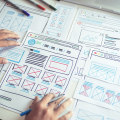Typography plays a crucial role in the field of user interface (UI) design. It is the art and technique of arranging type in order to make written language legible, readable, and appealing when displayed. In UI design, typography is not just about choosing a font or making text look pretty. It is also about enhancing usability and creating a visually appealing interface that captures the attention of users.
In this article, we will dive into the world of typography in UI design and explore how it can be used to improve the overall user experience. From understanding the basics of typography to applying best practices in layout and composition, we will cover everything you need to know to create effective and engaging UI designs. So, whether you are a beginner looking to learn the fundamentals or an experienced designer seeking to refine your skills, this article is for you. Let's get started!Typography plays a crucial role in user interface design.
It not only enhances the visual appeal of a website or mobile app, but also improves its usability. If you are looking to improve your UI design skills, understanding typography is essential. In this article, we will cover everything you need to know about typography in UI design. Firstly, let's discuss the basics of typography. This includes font types, sizes, and spacing.
These elements are important to consider when creating a user-centered design. The right font can greatly impact the overall user experience. For example, using a serif font can create a classic and traditional feel, while a sans-serif font gives off a modern and clean look. Next, let's explore responsive design for different devices. With the rise of mobile usage, having a responsive design that adapts to different screen sizes is crucial.
Typography can play a significant role in making your design responsive and accessible on all devices. Moving on, we will touch on the latest trends in UI and UX design. As technology continues to evolve, so do the trends in design. Some popular typography trends include bold and vibrant fonts, creative use of whitespace, and custom fonts. By staying up-to-date with these trends, you can make your design more visually appealing and engaging. In addition to tips and techniques, we will also provide resources and tools to help you with your own design projects.
These can range from font libraries and generators to design software and online courses. These resources will not only save you time and effort but also elevate your design skills. Subsequently, we will discuss the importance of consistency in typography. Consistency is key in creating a cohesive and professional design. We will cover how to maintain consistency in font choice, size, and spacing throughout your design. Lastly, we will address common mistakes to avoid when using typography in UI design.
These can include using too many font styles, poor readability, and inconsistent use of font hierarchy. By being aware of these mistakes, you can ensure that your design is effective and user-friendly. Images are an essential component of any UI design article. We will include visual examples to better illustrate the points mentioned in the text. These images will have descriptive titles and alt text for accessibility purposes. Overall, understanding typography in UI design is crucial for creating a successful user-centered design.
By following these tips and techniques, staying updated with the latest trends, and utilizing helpful resources, you can enhance the usability and visual appeal of your website or mobile app.
Resources and Tools
Font libraries: A font library is a collection of fonts that can be used in UI design. These libraries often offer a wide variety of fonts, both free and paid, that can be easily incorporated into your design. Some popular font libraries include Google Fonts, Adobe Fonts, and Font Squirrel.Font generators:
Font generators are online tools that allow you to create custom fonts for your UI design. They are a great resource for designers looking to add a unique touch to their designs.Some popular font generators include Fontjoy, FontStruct, and Prototypo.
Software:
There are also various software programs available specifically for typography in UI design. These include Adobe InDesign, Sketch, and Figma. These programs offer features such as font pairing suggestions, kerning adjustments, and more to help designers create visually appealing and usable typography.Online courses:
For those looking to improve their typography skills, there are also numerous online courses available. These courses cover topics such as typography principles, font selection, and how to incorporate typography into UI design.Some popular options include Coursera's Typography course and Skillshare's Typography Essentials course.
Responsive Design
When it comes to user interface design, it's important to consider the various devices that users will be accessing your website or app from. With the ever-increasing use of smartphones and tablets, creating a design that is responsive and adapts to different screen sizes is crucial. Responsive design refers to the ability of a website or app to automatically adjust its layout and content based on the screen size of the device being used. This ensures that users have a consistent and optimal experience, regardless of the device they are using. In order to achieve responsive design, designers must use HTML structure with media queries to target different screen sizes and make necessary adjustments.This allows for a fluid and flexible design that can adapt to any device, whether it's a desktop computer or a smartphone.
Choosing the Right Font
use HTML structure with font types, sizes, spacing, and their impact on user experience. Do not underestimate the power of font selection in UI design. A font that is too small or too fancy can make it difficult for users to read and understand the content on your website or app. On the other hand, a font that is too large can take up too much space and make your design look cluttered.When choosing a font for your UI, consider the purpose of your design and the target audience. For example, a sans-serif font may be more suitable for a modern and minimalistic design, while a serif font may be better for a more traditional and formal design. Additionally, pay attention to the spacing between letters and lines of text. Too much or too little spacing can also affect readability and user experience.
Keep in mind that the main goal of typography in UI design is to enhance usability and visual appeal, so choose fonts that are easy to read and aesthetically pleasing. Remember to also test your font choices on different devices and screen sizes to ensure consistency and readability across all platforms.
Current Typography Trends
Typography is constantly evolving and plays a crucial role in UI design. In order to keep up with the ever-changing landscape, it is important to stay updated on the current typography trends. In this section, we will discuss some of the top trends in typography that are shaping the world of UI design.Bold Fonts:
Bold fonts are becoming increasingly popular in UI design.They help create a strong visual impact and draw attention to important elements on a page. When used properly, bold fonts can also improve readability and make the content more engaging for users.
Creative Use of Whitespace:
Whitespace, also known as negative space, refers to the empty spaces between elements on a page. Designers are now using whitespace creatively to create a clean and minimalistic look for their UI designs. This not only helps improve readability but also gives the design a modern and sophisticated feel.Custom Fonts:
With the rise of web fonts and advancements in technology, designers now have access to a wide range of custom fonts to choose from.This has led to an increase in the use of unique and creative fonts in UI design, making it stand out from the crowd.
Common Mistakes to Avoid
Using too many font styles can make your UI design look cluttered and overwhelming for users. It is important to stick to a few font styles that complement each other and create a cohesive look. Additionally, poor readability can make it difficult for users to understand the content on your website or app. Make sure to choose legible fonts and use appropriate font sizes to improve readability.Lastly, inconsistent font hierarchy can confuse users and make it difficult for them to navigate through your design. Use a consistent font hierarchy to guide users and create a seamless experience.
Consistency in Typography
Consistency in typography is crucial for creating a cohesive and professional design in UI. This means using the same font, size, and style throughout the interface. It may seem like a small detail, but it can make a big difference in how users perceive and interact with your design.To achieve consistency, it is important to establish a set of typography rules and stick to them. This includes choosing a primary font and keeping font sizes consistent for headings, subheadings, and body text. Additionally, using consistent spacing and alignment can also contribute to a more cohesive design. Remember to use HTML structure with only for main keywords and for paragraphs, do not use "newline character".Typography is a crucial aspect of UI design that should not be overlooked.
By understanding the basics, staying updated with trends, and utilizing helpful resources, you can create a visually appealing and user-friendly design. Remember to maintain consistency and avoid common mistakes for the best results.


